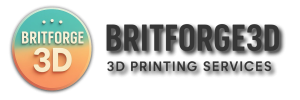The Basics of 3D Printing

Tutorials
The Basics of 3D Printing
What Every Beginner Should Know
Have you ever wanted to turn a digital idea into a real, physical object? That’s exactly what 3D printing allows you to do — and it’s more accessible than ever. Whether you’re a designer, student, hobbyist, or engineer, understanding the basics of 3D printing can open up exciting opportunities for creativity and innovation. In this comprehensive guide from BritForge 3D, you’ll learn how 3D printing works, what materials you can use, and why it’s changing the way we make things.
What is 3D Printing?
3D printing, also called additive manufacturing, is a process where objects are created layer by layer from digital designs. Unlike traditional methods that cut, drill, or cast shapes, 3D printing adds material exactly where it’s needed. This makes it possible to produce complex geometries that would be impossible or very expensive with conventional manufacturing.
How Does 3D Printing Work?
Here’s a simple breakdown of the process:
- Design: Create your 3D model using CAD software, or download it from sites like Printables or Thingiverse.
- Slicing: Use slicing software (e.g., Cura or PrusaSlicer) to convert your model into layers. The software also generates instructions for the printer.
- Printing: The printer follows these instructions, depositing material layer by layer until the part is complete.
This process can take anywhere from minutes to days, depending on the size, complexity, and printer settings.
Common Types of 3D Printing Technologies
For beginners, the two main types of 3D printing are:
- FDM (Fused Deposition Modelling): The most common and affordable option. FDM printers work by melting and extruding plastic filament through a nozzle, building parts one layer at a time. They’re great for prototyping, mechanical parts, and everyday items.
- SLA/DLP (Resin Printing): These use liquid resin cured by UV light for extremely detailed, smooth prints. SLA is ideal for jewellery, miniatures, or objects requiring fine detail, though it involves more post-processing.
Materials for 3D Printing
Choosing the right material is critical for your project’s success. The most popular beginner materials include:
- PLA: Easy to print, eco-friendly, and perfect for visual models or prototypes.
- PETG: Durable, flexible, and resistant to moisture, making it ideal for functional parts.
- ABS: Tough and heat-resistant, but more challenging to print due to warping.
- Resin: Used in SLA printing for high-detail parts with smooth surfaces.
Each material has its pros and cons depending on strength, flexibility, and appearance. Knowing these differences will help you select the best option for your project.
Benefits of 3D Printing vs. Traditional Manufacturing
3D printing offers several advantages over traditional manufacturing techniques:
- Faster prototyping reduce design cycles from weeks to days.
- Lower costs for small batches or one-off items.
- Freedom to design complex shapes and internal structures impossible with subtractive methods.
- Reduced material waste since only the needed material is used.
This flexibility makes 3D printing a powerful tool for startups, inventors, and anyone wanting to innovate on a budget.
Why Order 3D Prints Instead of Buying a Printer?
While owning a 3D printer can be rewarding, it requires time, maintenance, and knowledge to keep running smoothly. For many individuals and businesses, ordering prints from professionals like BritForge 3D saves time and ensures better quality. We use industrial-grade machines and provide a range of materials and finishes without you needing to worry about calibration, failures, or post-processing.
How to Get Started with BritForge 3D
Ready to turn your ideas into reality? Start by uploading your 3D model on our website. Our online tool gives you instant pricing, allows you to choose materials and finishes, and guides you through the process. Our experienced team will review your design, print your part with precision, and deliver it quickly — anywhere in the UK.
Conclusion
3D printing is revolutionising how we create, prototype, and manufacture. By learning the basics, you open doors to endless creative and professional possibilities. Whether you need help choosing materials, fixing your 3D model, or getting a part printed with industrial precision, BritForge 3D is here to support you every step of the way.
